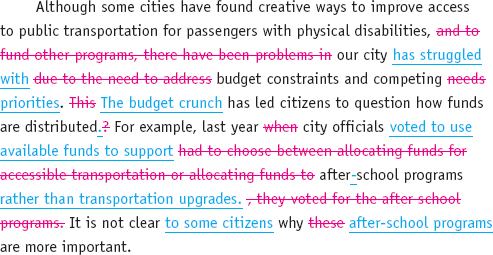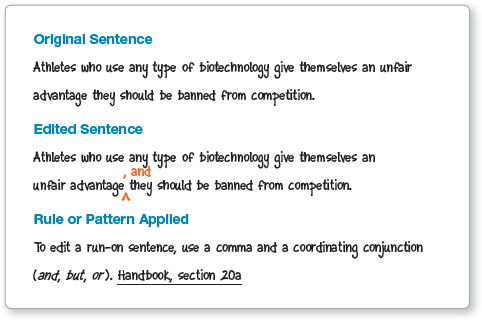2c. Revising and editing sentences; proofreading a final draft
When you revise sentences, you focus on effectiveness; when you edit, you check for correctness. Proofreading is a slow and careful reading in search of spelling errors, typos, and other obvious mistakes.
Revising and editing sentences
Much of this book offers advice on revising sentences for clarity and on editing them for grammar, punctuation, and mechanics.
Some writers handle sentence-level revisions directly at the computer, experimenting on-screen with a variety of possible improvements. Other writers prefer to print out a hard copy of the draft and mark it up before making changes in the file.
Here, for example, is a rough-draft paragraph as one student edited it on her computer for a variety of sentence-level problems.

The original paragraph was too wordy, a problem that can be addressed through any number of revisions. The following revision would also be acceptable.
Some cities have funded improved access to public transportation for passengers with physical disabilities. Because of budget constraints, our city chose to fund after-school programs rather than transportation programs. As a result, citizens have begun to question how funds are distributed and why certain programs are more important than others.
Some of the improvements in the first revision do not involve choice and must be fixed in any revision. For example, the hyphen in after-school programs is necessary; a noun must be substituted for the pronoun these in the last sentence; and the question mark in the second sentence must be changed to a period.
Proofreading
After revising and editing, you are ready to prepare your final copy. (See the appendix for formatting guidelines for your particular paper.) Make sure to allow yourself enough time for proofreading.
Proofreading is a special kind of reading: a slow and methodical search for misspellings, typographical mistakes, and omitted words or word endings. Such errors can be difficult to spot in your own work because you may read what you intended to write, not what is actually on the page. To fight this natural tendency, try one or more of the following tips.
PROOFREADING TIPS
- Remove distractions and allow yourself ten to fifteen minutes of pure concentration; turn off the TV and your cell phone and find a quiet place, away from people who are talking.
- Proofread out loud, articulating each word as it is actually written.
- Proofread hard copy pages; mistakes can be difficult to catch on-screen.
- Don’t rely too heavily on spell checkers and grammar checkers. Before automatically accepting their changes, consider their accuracy and appropriateness.
- Enlist a volunteer (a friend, roommate, or co-worker) to proofread after you.
Although proofreading may be slow, it is crucial. Errors strewn throughout an essay are distracting and annoying. If the writer doesn’t care about this piece of writing, the reader might wonder, “Why should I?” A carefully proofread essay, however, sends a positive message: It shows that you value your writing and respect your readers.
- The writing process > As you write: Proofreading your work
Creating a personal editing log
An important aspect of becoming a college writer is learning how to identify your grammar, punctuation, and spelling errors. You can use an editing log to keep a personal list of your common errors and learn the rules to correct the errors.
To begin your log, review all the errors identified on your last piece of writing. Use the following questions to guide the development of your personal editing log.
- What errors do you make most frequently?
- What pattern do you see in these errors?
- What rule(s) do you need to learn to correct the errors?
- Where in your handbook will you find the rules?
sample editing log page
